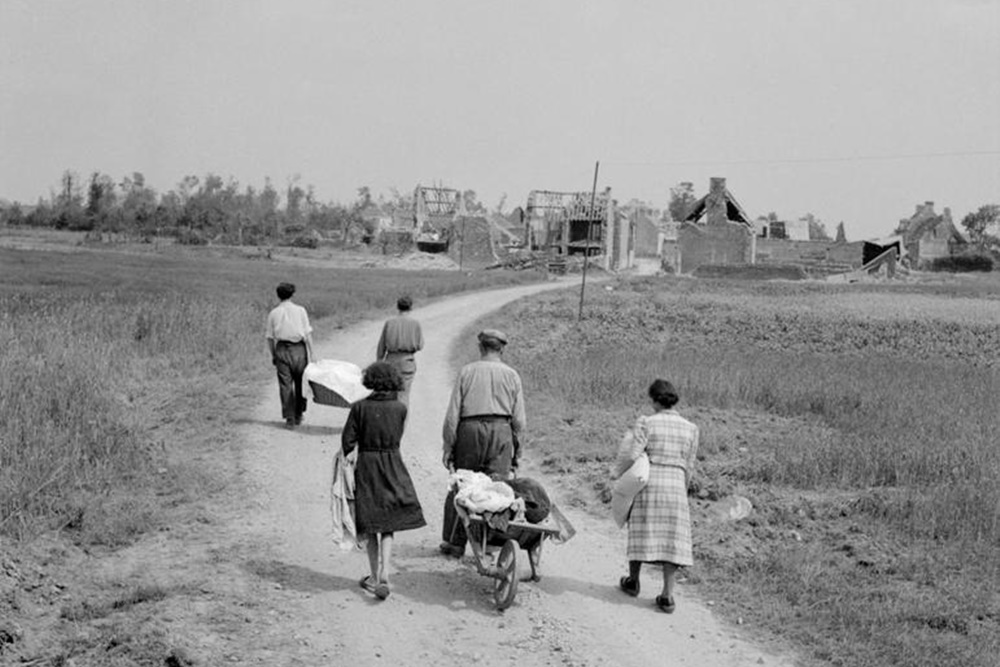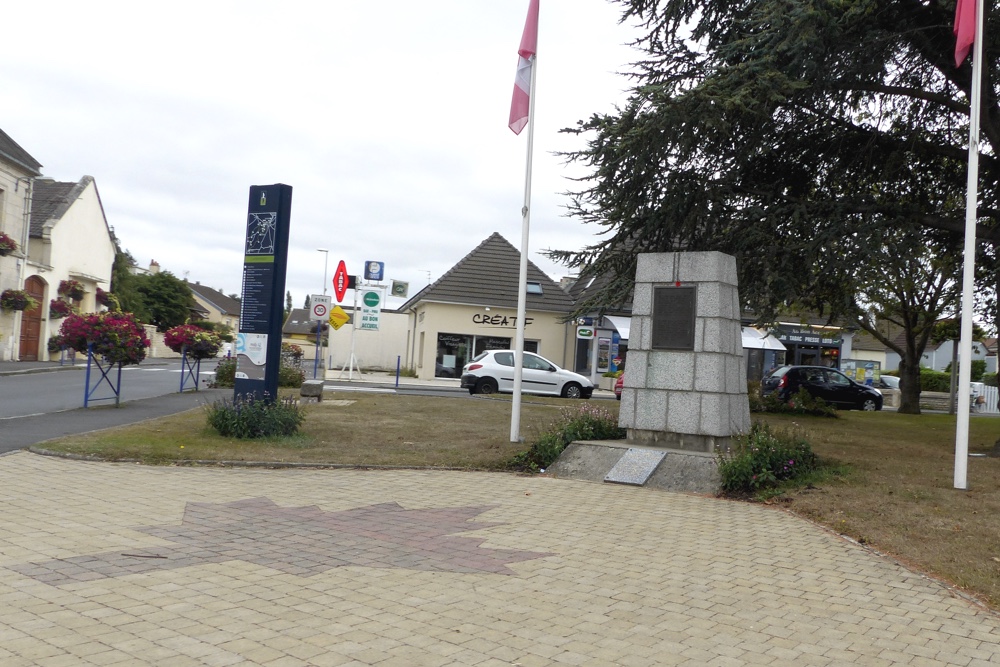The Story of Major Errol Stewart Gray
Major Errol Stewart Gray was born April 6, 1920 in Springhill, Nova Scotia in Canada. He stood 5 feet 6, had brown hair and brown-grey eyes.[1] The family consisted of father John James Gray and mother Anna Gertrude Gray. In addition to Errol, they had three other sons: John, Edward and Jim.[2] He joined the Canadian Field Force in the rank of 2nd Lieutenant. Meanwhile, he had moved to Amherst, his parents lived in Bedford. Gray worked as a technical clerk before he entered service. Since May 22, 1940, he served in the 2nd Battalion, North Nova Scotia Highlanders and so reported voluntary for service overseas.[3]
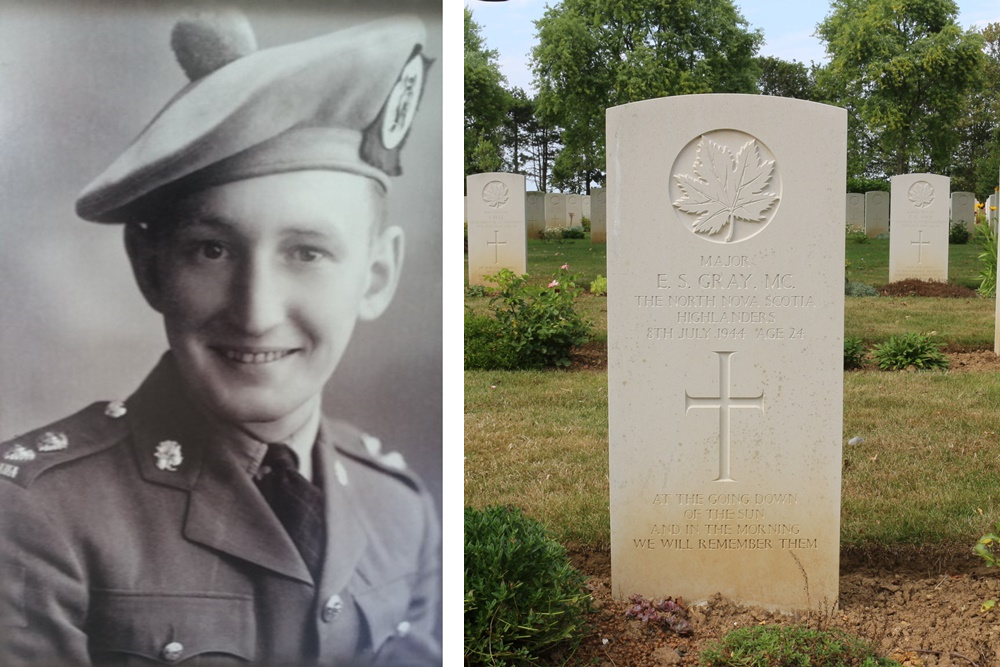
Major Errol Stewart Gray and his grave at the Canadian War Cemetery at Bény-sur-Mer. Source: Gray Family / Lennard Bolijn.
Gray wasn't sent to Great Britain right away. He first took a number of courses in Canada, including motorcycle lessons. October 3, 1941 saw him promoted to Lieutenant. He embarked for Great Britain on May 1, 1942 as reinforcement for the 1st Battalion, North Nova Scotia Highlanders. He arrived on May 1942.[4]
The battalion had come to Great Britain in the summer of 1941. Gray and his fellow officers are in a picture of the battalion, made on Christmas 1942 in Horsham, England.[5] This battalion became part of the 9th Infantry Brigade of the Canadian 3rd Infantry Division.
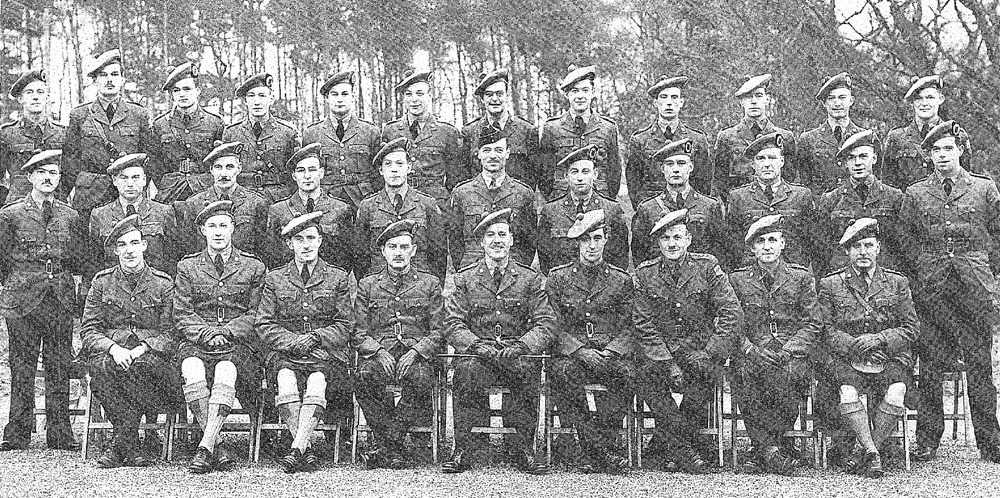
Officers of the North Nova Scotia Highlanders in Horsham, England. Gray is in the back row, fourth from the left.
Once in Great-Britain, Gray was promoted to Acting Captain on October 5, 1943, to be promoted to Captain on January 10, 1944[6] As Acting Captain, he actually still was a lieutenant but was promoted temporarily, in wartime usually because a position had been vacated. The holder of an Acting rank was being addressed as if holding the full rank though.
On June, 1944,[7] the order to embark for the amphibious landing in Normandy was finally issued. The North Nova's departed from Stokes Bay, a little north of the Isle of Wight on the southern coast of England. The unit's War Diary wrote: 'I wondered what was running through everyone's mind.'[8] One wonders if Captain Gray felt the same: boarding a ship and never to return.
D-Day, June 6, 1944
During Operation Overlord, Juno Beach was allocated to the Canadian 3rd Infantry Division. The 7th and 8th Infantry Brigade would go ashore first whereas the 9th Infantry Brigade would be kept in reserve. The first two brigades were to capture the bridgehead after which the 9th Infantry Brigade would come ashore and advance onto the goals for D-Day: the crossing of the highway between Caen and Bayeux and the capture the airfield of Carpiquet[9] located behind it.
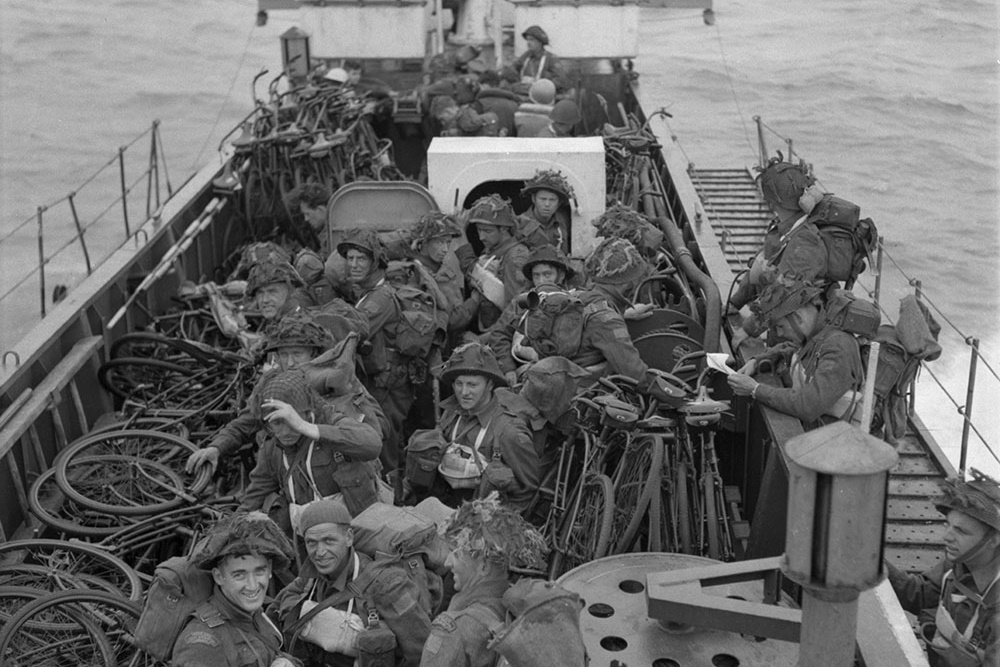
Soldiers of the Highland Light Infantry of Canada and the North Nova Scotia Highlanders aboard an LCI(L) bound for Normandy. Source: Library and Archives Canada / PA-133757.
On June 6, a little after 08:00, the two assault brigades came ashore on Juno Beach. It would take until about 11:00 hrs.[10] before the North Nova's got word to prepare for the landing. Forty minutes later they would land on Nan White Beach near Bernières-sur-Mer where earlier that morning the 8th Infantry Brigade had come ashore. Owing to delays right behind the beaches, it would take until 16:44 before the North Nova's reached Bény-sur-Mer, the actual jump off point for the battalion.[11]
Captain Gray had come ashore as commander of the carrier platoon. The advance on Carpiquet would be spearheaded by the Reconnaissance Troop of the Canadian 27th Armored Regiment. The Troop consisted of Honey (Stuart) tanks commanded by Lieutenant Kraus.[12] They were closely followed by Gray's carriers loaded with troops of C Company commanded by Captain Fraser.[13] They in turn were followed by other units. The point of the 9th Infantry Brigade was under command of Major Learment. They left at 18:20.[14] They were to advance along the present D 79.
At the intersection with the present D 220, they would have to turn right in the direction of Villons-les-Buissons, Buron, Authie, Franqueville and ultimately Carpiquet. If they missed the turn, they would end up in Caen in the sector of the British 3rd Infantry Division that had landed that day on Sword Beach.[15] Kraus raced across the intersection with his Honeys, straight towards Caen. Gray saw it happen and sped forward to warn Kraus. When he eventually succeeded, the first platoon of C company had already passed the important intersection.[16]
The pursuing platoon did manage to make the turn towards Villons-les-Buissons and encountered slight resistance. Eventually, Kraus' tanks managed to rejoin them[17] That night it was decided to hold out around the intersection as it had grown too dark to advance further.[18]
June 7, 1944
The next day, June 7, the advance on Carpiquet was resumed. Villons-les-Buissons was captured and they pushed on towards Les-Buissons on the road to Buron. Suddenly, an enormous bang was heard and one of the Honey tanks blew up. A German anti-tank gun had zeroed in on the road. Fraser and Gray prepared a quick assault. Fraser would create a diversion with C Company, enabling Gray to attack the gun with his carriers. Supported by mortars, Gray managed to launch an attack on the gun with his carriers and silenced it.[19] His citation describes the attack as follows: 'When he came under fire in Buron, he pressed on, managed to fight himself through fierce resistance and destroyed an enemy 88mm canon and a rocket launcher'.[20] The rocket launcher was a sixteen-barreled mortar, probably a Reihenwerfer.[21]
At 09:30[22] the advance on Buron continued where Gray and his troops managed to capture another 8mm canon.[23] For these actions, Gray was decorated with a Military Cross. Buron was eventually captured at 11:50.[24] Still preceded by the Honey tanks, the advance proceeded towards Authie. Meanwhile, the unit was heavily shelled by German units on its left flank from Saint-Contest.
Three carriers were sent to Authie, encountering only slight resistance from an orchard halfway between Buron and Authie.[25] In the outskirts of Authie, a few Honeys were put out of action by German anti-tank fire from the village.[26]
Gray dispatched two sections of his platoon to the left around Authie, on their way to Franqueville, the last village before the highway between Bayeux and Caen and the airfield. They were soon pushed back to the north of Authie by heavy German fire though.[27] A third section of carriers was sent up but didn't get any farther either.[28] Around 13:30, Gray's carriers were sent back to Buron.[29] Gray was the only one to stay behind with his own carrier in order to observe. Communication had been lost in the meantime. South of Buron, support by artillery was no longer possible. Fire support from the vessels off the coast could not be delivered either due to communication problems. Eventually, Gray would return to Buron as well himself. [30]
Kraus' Honey tanks on their way to Carpiquet found out that German tanks were moving about on their left flank. The II. Battalion 25. SS-Panzergrenadier-Regiment was stationed in and around Abbey d'Ardenne. This unit would inflict considerable losses on the Canadian 27th Armored Division as well as on the North Nova's and reaching the airport had become definitely impossible.[31] At 16:30 it transpired Authie could no longer be held and orders were issued to retreat to Buron.[32] The Germans continued their drive on Buron and managed to recapture it temporarily but the Canadians struck back and retook Buron. That night it was decided however to retreat farther to Les Buissons as Buron was impossible to hold with insufficient troops.[33]
This June 7 was a bad day for the North Nova's, one officer and ten other ranks were killed in action; three officers and twenty-seven men injured and nine officers and 195 men missing.[34] Later on, this was corrected to eighty-four dead, thirty injured and 128 taken prisoner.[35] Fraser was among the dead.[36]
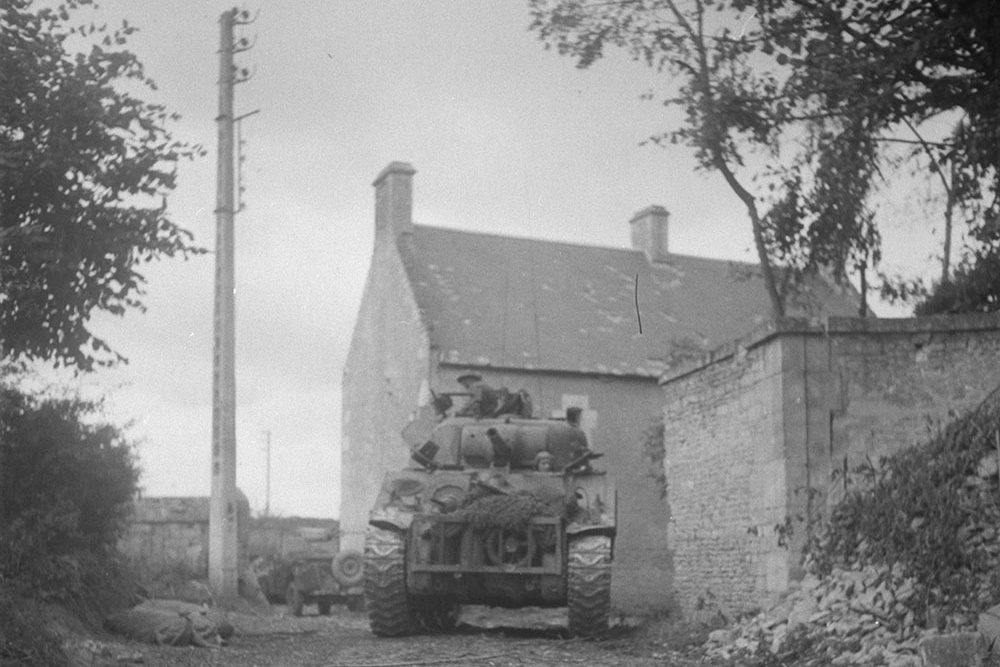
A Sherman tank of the 27th Canadian Armored Regiment in Buron, July 9, 1944. Source: Library and Archives Canada / PA-162692.
Relative quiet
The next days, the North Nova's were still holed up near Les Buissons. Some skirmishes took place but at the front, little changed. According to the War Diary, a 'minor accident' took place: 'During the night, when Major Edwards of the Highland Light Infantry, who was returning from patrol, jumped down on Major E.S. Gray, while the latter was enjoying a short rest in his trench. Major Gray's egg, his prized possession and the only one since D-Day seemed to have great possibilities for an evening meal, yielded – not a yoke – but a "grown duck".[37]
This was the first time, mention was made of Major Gray. He had been promoted to Acting Major[38] on June 9. Around this time, he was put in command of Company A as Major Rhodenizer,[39] its original commander, was one of the officers who had gone missing in action.[40] Gray can't have been promoted much later than that. Later on, it turned out, Rhodenizer[41] had been taken prisoner by the Germans
Five days later, June 16 by this time, it was still quiet. The battalion was still holed up in Les Buissons and killed its time patrolling. So little happened that the War Diary indicated that Major Gray, Captain Sutherland and CSM Paynter of A company took a bath that day. Two days later it was indicated that the entire battalion had taken a bath: it took place in the river La Mue near Fontaine-Henry.[42] Whether Gray himself took a bath in the river as well or in a real bath is unknown.
The days after were again spent patrolling. Many cows died by boobytraps and German mortars: 'So I guess we'll have more steaks in the near future'. At some time, A Company sounded the alarm as they saw a German patrol. It turned out to be two Poles in German service clearing a passage through the minefield. A Company was soon called jittery but reacted with: 'better to be jittery than dead'[43] On June 25, they found themselves still in the same location. A Company reported they had taken other cows as they gave more and better milk. On June 26, the North Nova's started preparing for Operation Aberlour. This would be a joint operation by the British 9th Infantry Brigade and the Canadian 9th Infantry Brigade. Eventually, this operation was canceled on June 28 and it remained quiet afterwards.[44] At the end of the month, the North Nova's were still in Les Buissons.[45]
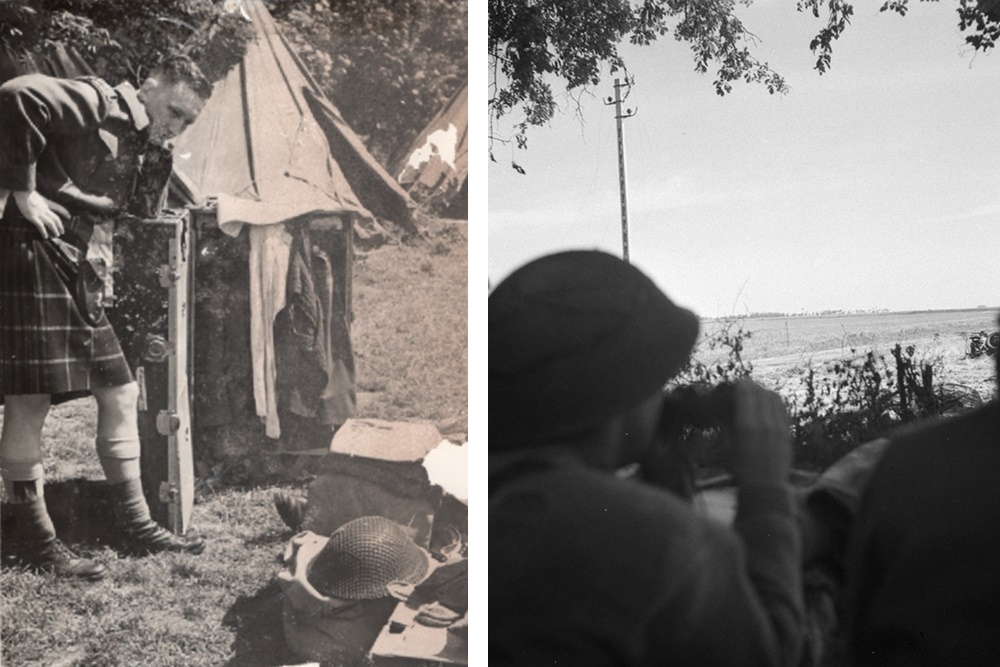
Major Gray (left) and The North Nova Scotia Highlanders in Normandy on 22 June 1944 (right). Source: Nova Scotia Highlanders Regimental Museum / Library and Archives Canada / PA-132919.
July 1944
On July 4, Operation Windsor was launched, the goal being the capture of Carpiquet airfield. This operation was carried out by the Canadian 8th Infantry Brigade. Part of the airfield would remain in German hands though after this operation. It was the springboard for the advance to the eventual capture of Caen which was the goal of Operation Charnwood.[46]
On July 7, the North Nova's were briefed about their role in the operation. Their task was to capture Authie. D Company would take the direct route (the present D 220) to Authie with B Company on its right and A Company on its left flank. C Company was kept in reserve and would eventually be sent to Franqueville. The attack was to begin the next day.
Operation Charnwood was launched on July 8. Buron had to be captured first before the North Nova's could advance on Authie. This task was carried out by the Highland Light Infantry, part of the Canadian 9th Infantry Brigade as well. Gruchy and Buron were captured simultaneously by the Stormont, Dundas and Glengarry Highlanders. After both villages had been secured, the North Nova's pushed on towards Authie at around 10:45.[47] The assembly area for the attack was an orchard south of Buron. Here the North Nova's were soon being subjected to heavy mortar and artillery fire. Major Gray died in this orchard at the age of 24.[48] Captain Sutherland took command of the company. At around 15:30,[49] the North Nova's succeeded in capturing Authie. The next day, the battalion would enter Caen.[50]
Major Errol Stewart Gray was buried in the Canadian War Cemetery near Bény-sur-Mer.
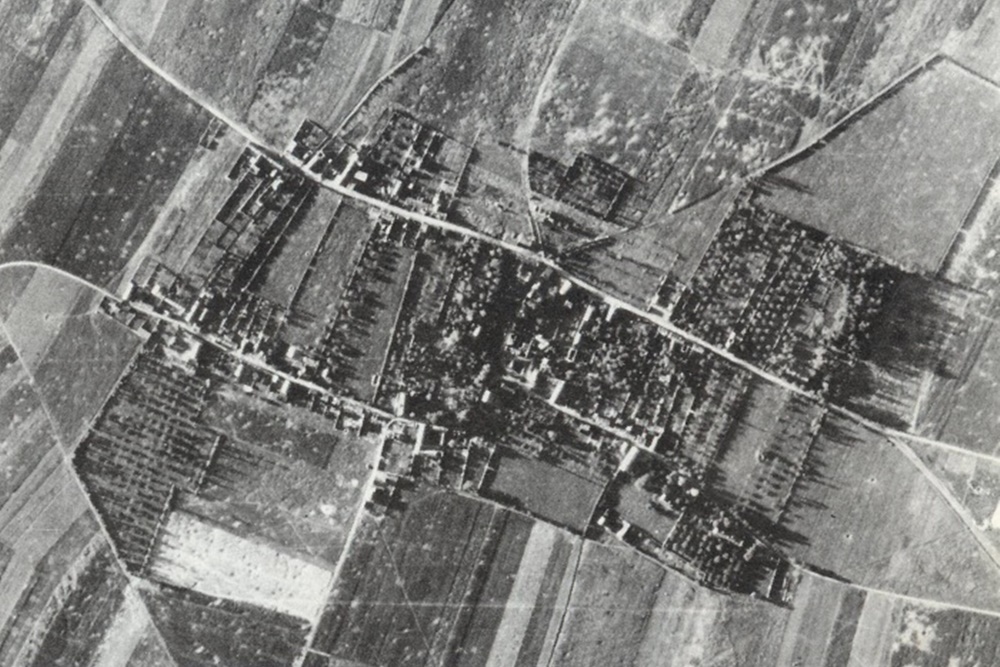
The heavily damaged Buron, with the orchard where Major Gray died at the bottom left. Source: canadiansoldiers.com.
Notes
- Statement of Service, E.S. Gray.
- Memorial plaque, E.S. Gray.
- Officer's Declaration Paper, E.S. Gray, June 5, 1941.
- Statement of Service, E.S. Gray.
- Learment, page 93.
- Statement of Service, E.S. Gray.
- WO 179-2948; Statement of Service, E.S. Gray.
- WO 179-2948.
- Juno Beach, page 306.
- WO 179-2948 states 11:00 hrs; Stacey, page 110 states 10:50 hrs; Learment, page 93 states 10:30 hrs. T-12331 states 10:30 hrs.
- WO 179-2948.
- Juno Beach, page 306; T-12758.
- Juno Beach, page 307.
- WO 179-2948; Stacey, page 111; Learment, page 94 states 18:00 hrs; T-12758 states 19:00 hrs.
- Juno Beach, page 307.
- Juno Beach, page 308.
- Juno Beach, page 308.
- WO 179-2948; Juno Beach, page 308; Stacey, page 11; T-12331.
- Holding Juno, page 89; T-12758; Interview Wilson/Gray, page 1.
- WO 373/48/482.
- Holding Juno, page 89 'sixteen-barreled mortar'; WO 179-2948 'a 16 barreled German mortar'; Ellis, page 229 mentions a 'six-barreled mortar'.
- WO 179-2948.
- WO 373/48/482.
- WO 179-2948; Stacey, page 128.
- Interview Wilson/Gray, page 1.
- Holding Juno, page 91.
- Holding Juno, page 92.
- Interview Wilson/Gray, page 2.
- Holding Juno, page 91.
- Interview Wilson/Gray, page 2.
- Holding Juno, page 91.
- WO 179-2948.
- WO 179-2948; Stacey, page 132; Ellis, page 229.
- WO 179-2948.
- Stacey, page 132.
- Learment, page 93; cwgc.org.
- WO 179-2948.
- Statement of Service, E.S. Gray.
- Juno Beach, page 295.
- WO 179-2948.
- Learment, page 96.
- WO 179-2948.
- WO 179-2948.
- WO 179-2948; Stacey, page 150; T-12331.
- WO 179-2948.
- WO 179-2948.
- WO 179-2948.
- Breakout from Juno, page 69 & WO 179-2948.
- WO 179-2948; Ellis, page 315.
- WO 179-2948; T-12332.
Definitielijst
- Brigade
- Consisted mostly of two or more regiments. Could operate independently or as part of a division. Sometimes they were part of a corps instead of a division. In theory a brigade consisted of 5,000 to 7,000 men.
- D-Day
- The day of the long awaited invasion of western Europe in Normandy, France, 6 June 1944. After a long campaign of deception the allies attacked the coast of Normandy on five beaches to begin their march on Nazi Germany. Often explained as Decision Day, though this is entirely correct. The D stands for Day as generally used in military language. In this case it means an operation beginning on day D at hour H. Hence “Jour J“ in French.
- Infantry
- Foot soldiers of a given army.
- mortar
- Canon that is able to fire its grenades, in a very curved trajectory at short range.
- Regiment
- Part of a division. A division divided into a number of regiments. In the army traditionally the name of the major organised unit of one type of weapon.
- resistance
- Resistance against the enemy. Often also with armed resources.
- rocket
- A projectile propelled by a rearward facing series of explosions.
Information
- Article by:
- Jeroen Koppes
- Translated by:
- Arnold Palthe
- Published on:
- 28-03-2021
- Last edit on:
- 30-09-2024
- Feedback?
- Send it!
The War Illustrated
Related sights
Related books
Sources
- ELLIS, L.F., Victory in the West, Volume I.
- FORD, K., Caen 1944.
- STACEY, C.P., The Victory Campaign.
- ZUEHLKE, M., Breakout from Juno, Douglas & McIntyre, Vancouver, Canada, 2011.
- ZUEHLKE, M., Holding Juno, Douglas & McIntyre, Vancouver, Canada, 2006.
- ZUEHLKE, M., Juno Beach, Douglas & McIntyre, Vancouver, Canada, 2005.
- Officer's Declaration Paper, E.S. Gray.
- Memorial plaque, E.S. Gray.
- Statement of Service, E.S. Gray.
- Learment, Don "Soldier, Pow, Partisan: My Experiences during the Battle of France, June – September 1944." Canadian Military History 9, 2 (2000).
- Library and Archives Canada; T-12331, Headquarters 9th Canadian Infantry Brigade.
- Library and Archives Canada; T-12332, Headquarters 9th Canadian Infantry Brigade.
- Library and Archives Canada; T-12758, 27th Armoured Regiment (Sherbrooke Fusiliers Regiment).
- The National Archives; WO 179-2948, North Nova Scotia Highlanders, 1944.
- The National Archives; WO 373/48/482, Recommendation for Award for Gray, Errol Stewart.
- Memorandum of Interviews with Capt (A/Maj) A.J. Wilson, Nth NS Highrs, 18 Jun 44 and Capt (A/Maj) Gray, Nth NS Highrs, 29 Jun 44 by Historical Officer: The Engagement at Buron and Authie, 7 Jun 44. Via Mark Zuehlke.
- The Orne (Buron) - canadiansoldiers.com
Acknowledgements:
- Lennard Bolijn
- Fred Bolle
- Michael Doresh, canadiansoldiers.com
- William Gray
- Arnold Palthe
- John Wales, Nova Scotia Highlanders Regimental Museum
- Mark Zuehlke
